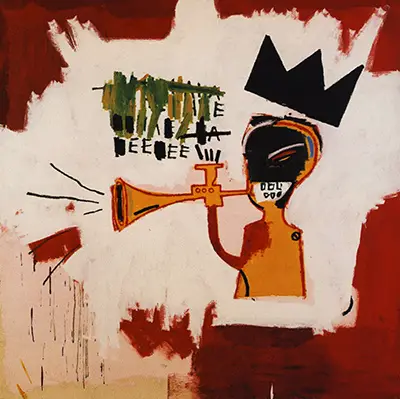Painted in 1984, it possesses the various elements that have been found to be consistent with features found in the over 2000 drawings and paintings that Basquiat made in his career before his untimely death in 1988.
The bright striking colours, the stick-figures, the references to historical figures and occurrences, the signature writing of words and poetry and having them crossed out; not to forget his love of Jazz. 'Trumpet' was the work of Basquiat in his element.
Trumpet is an acrylic and oil stick painting on canvas. It features an image of an individual playing a trumpet while wearing a crown on a white background with a deep red on the fringes.
There's a series of letters and images above the trumpet being played; a couple of the letters are crossed out while some are written beneath the images that are all joined together in a pattern. The crown worn by the individual is black. The black colour extends to the individual's face as well.
Many of the portraits in Basquiat's pieces often wore a crown. This was due to his insistence on the importance of the intellectual over the superficial. He often regarded himself not as a black artist but just as artist. He didn't want the public to view him through the prism of his race as that distorted their view.
Having the black colour of the man's face extend to the crown indicates the need for black people to embrace intellectualism as a means to greatness. The trumpet being played is an expression of his love for jazz; a genre of music he also composed and played. Trumpet is one among many of Basquiat's works that not only pay homage to the legends of Jazz but also tell a story of black struggle at a time of widespread racism.
Trumpet was one of the markers of a young Basquiat who had just had his first taste of success in the world of Art. He had just previously been part of an art duo called SAMO that had made a name for itself in New York for its cryptic epigrams and other art pieces made on trains and train stations.
He slowly garnered some fame little by little and was soon exhibiting his art materials in galleries in New York and other cities in America. This paved the way for his work to be showcased at the world's most respected art galleries in France and Italy.
Basquiat's work was fiery and radical. Add the fact that he was a young black person who didn't conform to the status quo, many individuals in Art circles were not willing to embrace him purely out of bigotry and hardwired racism. Despite all this negativity, he still prevailed owing to the undeniable brilliance of his work. The art made around this point in time, e.g. Trumpet, point to a man fiercely holding on to his pride and letting the world know it. It is a show of defiance; a show of black excellence in the face of adversity.
Trumpet and other Basquiat paintings told the world a story of his Afro-Caribbean heritage that was both Haitian and Puerto Rican. A young man who quickly ascended from spray-painting in the familiar streets of New York to exhibiting his artwork beside the World's most respected artists purely due to the emotion, pride, richness and visual excellence found in his work. He was barely into his twenties when he had his breakthrough but it's paintings like 'Trumpet' which made the world listen to what he had he had to say.



